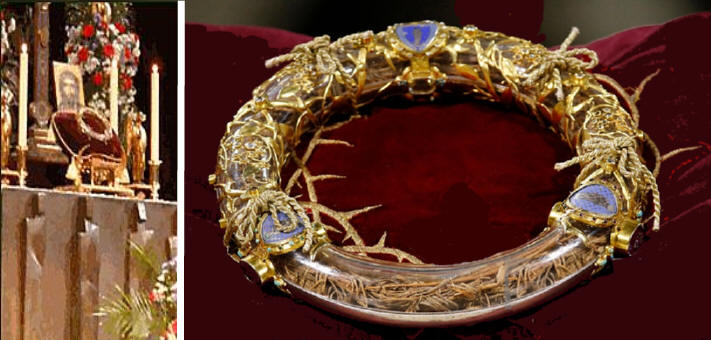
It is currently housed in the Notre-Dame cathedral in Paris.
According to three of the Gospels, a woven crown of thorns was placed on the head of Jesus during the events leading up to his crucifixion. After numerous studies, and historical and scientific research, there is still no way to certify its authenticity. Sceptics say that it is unlikely that anyone at the time would have bothered to save such a shameul and demeaning object.
It is housed at the Notre Dame Cathedral in Paris, where it has been since 1239.
Its origins are sketchy and can only be traced back to the 4th century when, in AD 409, Saint Paulinus mentions a similar relic which was kept in a basilica in Jerusalem. Then in 570 it is documented that the Crown of Thorns was exhibited for veneration at another basilica and so on.
Over the years many relics including the Crown of Thorns were moved to the Byzantine Emperors chapel during the 7th 8th 9th and 10th centuries, and this chapel was located in Constantinople, now known as Istanbul, and the main reason for moving the relics was to keep them safe from pillaging.
Justinian is stated to have given a thorn to St. Germain, Bishop of Paris, where it was long preserved. The Empress Irene, in 798 or 802, sent Charlemagne several thorns which were deposited by him at Aachen. Eight of these can be traced without difficulty. Four were given to Saint-Corneille of Compiagne in 877 by Charles the Bald. The Duke of the Franks, sent one to the Anglo-Saxon King Athelstan in 927, and it eventually found its way to Malmesbury Abbey. Another was presented to a Spanish princess about 1160 and again another was taken to Andechs Abbey in Germany in the year 1200.
In 1238 the Latin Emperor, Baldwin II, found himself in great financial difficulties. To obtain credit he pawned the Crown of Thorns along with other relics to a venetian merchant bank. King Louis IX of France paid off the Venetians and took over the relics.
On August 10, 1239, the King exposed 29 relics in Villeneuve-lArcheveque in the Burgundy region of France, and from there the procession continued on towards Paris. They arrived there on August 19 where King Louis took off his royal attire and wearing only a simple tunic (now a relic in its own right) and bare feet, continued on to the Notre Dame de Paris Cathedral (accompanied by his brother and the rest of the procession). There the King had a chapel shrine constructed for the Crown of Thorns.
These relics were held at the Notre Dame cathedral for a short time while the chapel was being finished. They remained there until the French Revolution, when they were stored within the National Library for safe keeping. After the French Revolution, in 1801 there was an agreement reached between Napoleon Bonaparte and papal and clerical representatives in Rome and Paris that defined the status of the Roman Catholic Church in France
Napoleon offered a reliquary for The Crown of Thorns and the relics were then eventually given back to the Archbishop of Paris, who placed them within the Treasury of the Notre Dame Cathedral on 1806, which is where they still remain today.
Authentic replicas from the Holy Land looking more genuine than the one at Notre Dame,are available at computer sources for less than $20.